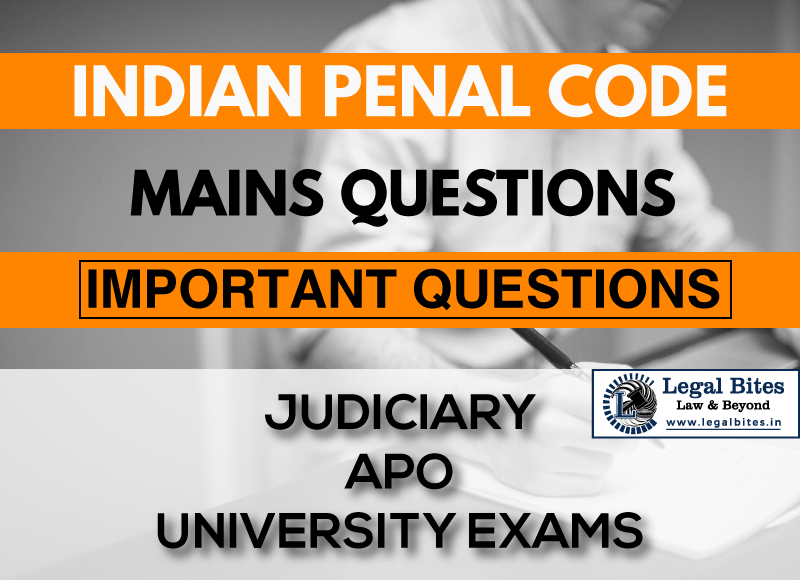When is a person said to make a false document? Discuss also ‘forged document’.
Question: When is a person said to make a false document? Discuss also ‘forged document’. Find the answer to the mains question only on Legal Bites. [When is a person said to make a false document? Discuss also ‘forged document’.] Answer Section 463 of the Indian Penal Code, 1860 defines the offence of forgery, and Section 464 of… Read More »

Question: When is a person said to make a false document? Discuss also ‘forged document’. Find the answer to the mains question only on Legal Bites. [When is a person said to make a false document? Discuss also ‘forged document’.] Answer Section 463 of the Indian Penal Code, 1860 defines the offence of forgery, and Section 464 of IPC, 1860 substantiates the same by providing an answer as to when a false document could be said to have been made for the purpose of committing an offence...
Question: When is a person said to make a false document? Discuss also ‘forged document’.
Find the answer to the mains question only on Legal Bites. [When is a person said to make a false document? Discuss also ‘forged document’.]
Answer
Section 463 of the Indian Penal Code, 1860 defines the offence of forgery, and Section 464 of IPC, 1860 substantiates the same by providing an answer as to when a false document could be said to have been made for the purpose of committing an offence of forgery under Section 463 of the Indian Penal Code, 1860. Therefore, it can be stated that Section 464 of the Indian Penal Code, 1860 defines one of the ingredients of forgery that is, making a false document.
In the matter of Md. Ibrahim & Ors v. State of Bihar & Anr, (2009) 8 SCC 751, it was held that a person is said to have made a ‘false document’, if:
- He made or executed a document claiming to be someone else or authorized by someone else; or,
- He altered or tampered a document; or,
- He obtained a document by practising deception, or from a person not in control of his senses.
Section 464 elaborates the provision on making a false document—
A person is said to make a false document or false electronic record—
First— Who dishonestly or fraudulently—
- makes, signs, seals, or executes a document or part of a document;
- makes or transmits any electronic record or part of any electronic record;
- affixes any electronic signature on any electronic record;
- makes any mark denoting the execution of a document or the authenticity of the electronic signature,
with the intention of causing it to be believed that such document or part of the document, electronic record or electronic signature was made, signed, sealed, executed, transmitted, or affixed by or by the authority of a person by whom or by whose authority he knows that it was not made, signed, sealed, executed, or affixed; or
Secondly—Who, without lawful authority, dishonestly or fraudulently, by cancellation or otherwise, alters a document or an electronic record in any material part thereof, after it has been made, executed, or affixed with electronic signature either by himself or by any other person, whether such person be living or dead at the time of such alteration; or
Thirdly—Who dishonestly or fraudulently causes any person to sign, seal, execute or alter a document or an electronic record or to affix his electronic signature on any electronic record knowing that such person by reason of unsoundness of mind or intoxication cannot, or that by reason of deception practised upon him, he does not know the contents of the document or electronic record or the nature of the alteration.
The basic elements of making a forged document
1. Forgery requires Deception
In most of the jurisdiction, the crime of forgery is not imposed unless it is done with the intent to commit fraud larceny. For example, the work of art can be replicated or copied without any crime being committed unless someone attempted to sell or represent the original copies. In such cases, the act would be considered an illegal forgery.
2. Creation of fake document
Forgery also includes the creation of fraudulent or fake documents. For instance, it can involve photocopying of the person’s signature and then artificially placing it on a document without their knowledge or consent. Moreover, On the grand scale forgery occurs in the field of art and literature.
3. Forgery as Identity Theft
Identity theft is a crime wherein the defendant unjustly acquires and uses another’s person personal data in some way that involves fraud or deception typically for budgetary gain.
Initially, states have treated identity theft as deceptive imitation forgery or as theft by deception.
4. The intention of the forger
Section 468 pertains only to the cases where forgery is for the purpose of cheating. Forgery has been explained before as concerning the presence of one or other of the two elements of dishonesty or fraud.
Important Mains Questions Series for Judiciary, APO & University Exams
- IPC Mains Questions Series Part I: Important Questions
- IPC Mains Questions Series Part II: Important Questions
- IPC Mains Questions Series Part III: Important Questions
- IPC Mains Questions Series Part IV: Important Questions
- IPC Mains Questions Series Part V: Important Questions
- IPC Mains Questions Series Part VI: Important Questions
- IPC Mains Questions Series Part VII: Important Questions
- IPC Mains Questions Series Part VIII: Important Questions
- IPC Mains Questions Series Part IX: Important Questions
- IPC Mains Questions Series Part X: Important Questions
Admin Legal Bites
Legal Bites Study Materials correspond to what is taught in law schools and what is tested in competitive exams. It pledges to offer a competitive advantage, prepare for tests, and save a lot of money.

